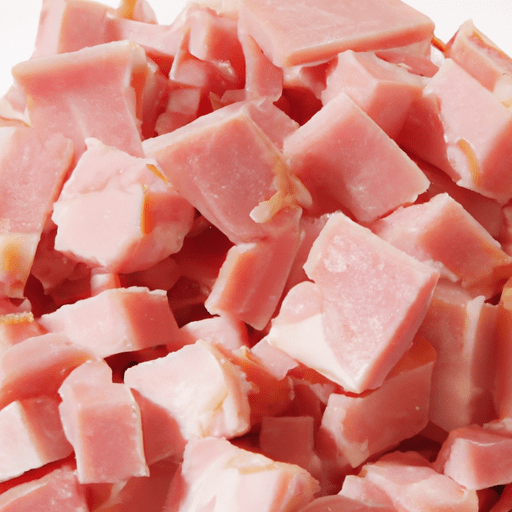Ham Cubes: A Versatile Ingredient for Flavorful Dishes
If you’re looking for a versatile ingredient to add a burst of flavor to your meals, look no further than ham cubes. These bite-sized gems can elevate the taste of a wide variety of dishes, from soups and stews to salads and omelets. In this blog post, we’ll delve into the world of ham cubes, exploring their taste, common uses in cooking, nutritional value, and uncovering some interesting history and facts about this underrated ingredient.
Taste
Ham cubes offer a rich and savory flavor profile that can add depth and complexity to any dish. The meat is cured and often smoked, which lends it a distinctive smoky and slightly salty taste. The cubes have a tender yet firm texture that holds up well during cooking, making them a delightful addition to both hearty main dishes and lighter fare.
Common Uses in Cooking
Ham cubes are a versatile ingredient that can be incorporated into numerous dishes to enhance their taste. Here are some common ways they are used in cooking:
Soups and Stews: Whether you’re making a comforting split pea soup or a robust bean stew, adding ham cubes can infuse the broth with incredible flavor. As the cubes simmer and release their smoky essence, they create a comforting and deeply satisfying dish.
Casseroles and Quiches: Ham cubes can bring a delightful twist to traditional casseroles and quiches. Sprinkle them into a creamy pasta bake or fold them into a fluffy quiche to inject a burst of flavor and texture into these crowd-pleasing favorites.
Salads: For an unexpected twist on salads, toss in some ham cubes. Their smokiness pairs beautifully with fresh greens, adding a savory element that complements other ingredients like cheese, tomatoes, or tangy dressings.
Omelets and Frittatas: Ham cubes make a fantastic addition to omelets and frittatas, offering a protein-packed punch that boosts the overall taste. Whether you’re making a classic ham and cheese omelet or a veggie-packed frittata, these cubes will take your breakfast game up a notch.
Nutritional Value
Besides being a flavorful ingredient, ham cubes also pack a nutritional punch. While they are a source of protein, they should be consumed in moderation due to their sodium content. Here’s a breakdown of the nutritional value of ham cubes per 3-ounce serving:
- Calories: 120
- Protein: 21g
- Fat: 4g
- Sodium: 990mg
It’s worth noting that the sodium content can vary depending on the brand or preparation method, so be sure to check the packaging for accurate information.
History and Facts
Ham cubes have a long history, dating back to ancient times. The practice of curing and smoking meat was developed as a way to preserve it before the invention of refrigeration. Over time, this technique evolved, and ham cubes became a popular choice as a flavorful pantry staple.
Interestingly, ham cubes are often made from the less visually appealing or smaller pieces of ham that may not be sold as standalone cuts. This makes them an economical choice for adding that delightful ham flavor to your dishes without breaking the bank.
In many cultures, ham is also associated with holiday feasts and traditional celebrations. From glazed ham on Thanksgiving in the United States to “jamon serrano” in Spain during Christmas, ham cubes add a special touch to these festive occasions.
So, the next time you’re looking to enhance the taste of your dishes, consider incorporating ham cubes. Their rich flavor, versatility, and interesting history make them a staple ingredient worth experimenting with. From soups to omelets, these little cubes will undoubtedly leave a lasting impression on your taste buds. Happy cooking!
Ham Cubes
Here are some interesting facts about ham cubes:
Origin: Ham cubes are small pieces of ham that are typically cut from the leg of a pig. Ham, in its various forms, has been consumed for centuries and is believed to have originated in Europe, where it was salted and dried to preserve meat.
Common Uses: Ham cubes are versatile ingredients used in a variety of dishes. They are commonly added to soups, stews, casseroles, and salads to add flavor and texture. Ham cubes are also a popular addition to breakfast dishes such as omelets, quiches, and scrambled eggs.
Nutritional Benefits: Ham cubes are a good source of protein, which is essential for building and repairing tissues in the body. They also provide important nutrients like vitamins B6 and B12 and minerals such as zinc and phosphorus. However, it is important to note that ham cubes can be high in sodium and saturated fat, so moderation is advised.
Unique Properties: Ham cubes have a distinctive smoky and savory flavor, which can enhance the taste of a wide range of dishes. They are often chosen for their salty and rich taste, adding depth and complexity to recipes. Additionally, because they are already cooked, ham cubes can be conveniently added to recipes without requiring further cooking time.
Historical Significance: Ham has been an important meat preservation method throughout history. In ancient times, it served as a staple food source, allowing communities to have access to protein during times of scarcity. The curing and smoking of ham allowed it to be stored for extended periods, making it a valuable commodity and food source for explorers and settlers during their long journeys.
Remember, when using ham cubes in recipes, it’s important to consider the overall nutritional composition of the dish and to consume them in moderation as part of a balanced diet.




Use the share button below if you liked it.
It makes me smile, when I see it.